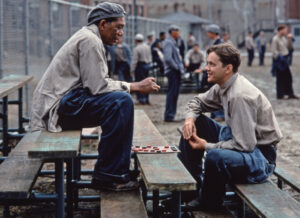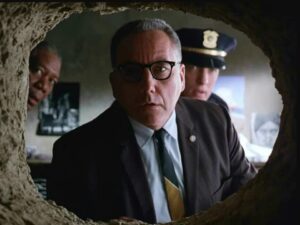The Shawshank Redemption
In the vast landscape of cinematic treasures, few movies have etched their place in popular culture as profoundly as “The Shawshank Redemption.” Released in 1994 and adapted from Stephen King’s novella, this masterpiece directed by Frank Darabont has transcended its status as a mere film to become a symbol of hope, resilience, friendship, and redemption that continues to captivate audiences worldwide.
At its core, “The Shawshank Redemption” is a story about the triumph of the human spirit in the face of adversity. Set against the grim backdrop of Shawshank State Penitentiary, the movie introduces us to Andy Dufresne, a mild-mannered banker who finds himself wrongly convicted of a crime he didn’t commit. As the narrative unfolds, we are taken on a journey through the prison’s oppressive walls, witnessing Andy’s unwavering determination to retain his humanity and ultimately find freedom.

“Get busy living or get busy dying.”
This iconic line, delivered by Andy Dufresne (played brilliantly by Tim Robbins), encapsulates one of the central themes of the movie: the power of choice. Even in the bleakest of circumstances, Andy refuses to succumb to despair. Instead, he chooses to “get busy living” by using his skills to improve the prison and forge connections with fellow inmates. This philosophy echoes a profound life lesson – that our reactions to adversity are within our control, and our decisions shape our destinies.
Andy’s actions inspire those around him, particularly his close friendship with Ellis “Red” Redding (portrayed by Morgan Freeman). Red serves as both narrator and a mirror to the audience, reflecting on the transformative effect of hope and friendship. Their bond illustrates the significance of human connections, proving that even in the harshest environments, genuine relationships can flourish and bring solace.
“Hope is a good thing, maybe the best of things.”
Hope is the lifeblood of “The Shawshank Redemption.” Andy’s unshakable belief in a better future is a driving force not only for himself but also for those who come to know him. The poster of Rita Hayworth that conceals his escape tunnel becomes a powerful symbol of the hope that lies beyond the prison walls. This concept of hope as a lifeline, as something to cling to when all else seems lost, resonates deeply with viewers.
The character Brooks Hatlen (James Whitmore) embodies the tragic consequences of a lack of hope. After spending decades in Shawshank, he is released into a world that has moved on without him. Brooks’s struggle to adapt underscores the importance of nurturing hope, as it can serve as a compass guiding us through the challenges of life’s ever-changing landscapes.

“Redemption”
Redemption is a central theme woven intricately throughout the film. The title itself, “The Shawshank Redemption,” speaks to the idea of seeking salvation and transformation. Andy’s actions, from his financial expertise that benefits both inmates and the prison staff to his escape plan, reflect his journey toward personal redemption. Similarly, Red’s gradual transformation from a cynical, institutionalized inmate to a hopeful and liberated individual highlights the power of self-discovery and growth.
The character of Tommy Williams (Gil Bellows) adds another layer to the theme of redemption. His tragic fate underscores the unfairness of the justice system and serves as a reminder that even the most well-intentioned efforts at redemption can be thwarted by external forces. Yet, his story also emphasizes the importance of fighting for justice and truth, even when the odds are stacked against us.
“I guess it comes down to a simple choice, really.”
The choices we make define us, and this sentiment reverberates throughout the movie. Whether it’s Andy’s decision to play Mozart over the prison loudspeakers or his determination to escape, the film underscores that our actions have far-reaching consequences. Captain Byron Hadley’s (Clancy Brown) eventual arrest serves as a testament to the principle that justice will catch up to those who abuse their power.
Moreover, the parole board scenes involving Brooks and Red further illustrate the significance of choice. While Brooks struggles to adapt to freedom and ultimately takes his own life, Red chooses to embrace the opportunity for change. His poignant words during his parole hearings reflect a profound realization that redemption requires effort and a willingness to confront one’s past mistakes.
“Remember, Red, hope is a good thing, maybe the best of things, and no good thing ever dies.”
The closing moments of the film are nothing short of cathartic. As Red journeys to Zihuatanejo, the Pacific paradise Andy dreamed of, he discovers a letter and money left behind by his friend. This heartwarming conclusion reaffirms the enduring power of hope and the lasting impact of genuine connections. It signifies that the ripples of our actions can extend far beyond our immediate circumstances.

“The Shawshank Redemption” isn’t just a movie; it’s a philosophical exploration of the human experience. Its universal themes of hope, friendship, redemption, and the power of choice continue to reverberate in popular culture. Whether through Andy’s quiet resolve, Red’s introspective narration, or the poignant moments shared by the inmates, the film imparts valuable life lessons that resonate across generations. In a world often clouded by cynicism and despair, “The Shawshank Redemption” stands as a shining beacon of light, reminding us that even in the darkest of times, we possess the agency to shape our destinies. It encourages us to nurture hope, cultivate meaningful relationships, seek redemption, and make choices that align with our values. As we journey through life’s twists and turns, let us remember that, like Andy and Red, we have the power to create our own redemption stories – stories that inspire, uplift, and endure.